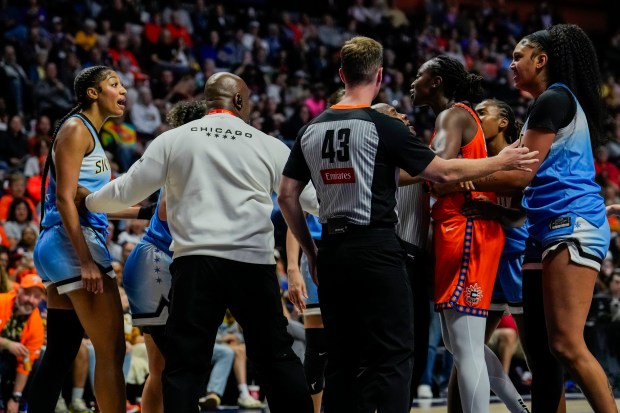On May 25, 1950, Walter Skonicki sat down on his couch to perform his evening ritual of listening to the radio or perusing the newspapers.
“What the heck!” he exclaimed upon hearing an explosion and feeling a blast of air coming through his living room window at 6242 S. State St. Looking out, he got a preview of the Tribune’s front-page headline the next morning: “TRUCK-TROLLEY FIRE! 33 DIE.”
The accompanying story reported that the fuel in a gasoline tanker became a fireball after colliding with a rush-hour streetcar, a sleek new model dubbed the “Green Hornet.” The death toll was later estimated at 34.
The disaster resulted from a chain of events that started with a heavy rainfall on that May day, all of them laid out in detail in Craig Cleve’s book “The Green Hornet Streetcar Disaster,” from which much of this account is taken.
At 2:30 p.m., Peter Duggan, a CTA supervisor, reported that a viaduct at State and 63rd was flooded. Southbound streetcars would have to stop at 62nd Place and be sent northbound. To provide for such contingences, the CTA built reversing loops at intervals along its streetcar lines.
Duggan asked for a flagman to hold up one of the trains when he pushed a long iron lever into the turnout’s switching mechanism. Charles Kleim, a bus driver who’d finished his shift, was sent to warn approaching streetcars, but without a flag. That was not unusual.
At the 62nd Place turnout, Kleim, who had waved down 200 streetcars with his bare hand, saw one more. It was going too fast and ignoring his frantic signals. As Kleim desperately ran toward it, the streetcar lurched into the turnout. It was trailed by the sound of crunching metal and screaming passengers.
With the 63rd Street underpass now open a southbound Mack Truck drove through it. Mel Wilson, the driver, was bringing 4,000 gallons of gasoline from an Indiana refinery.
Shortly after emerging from the underpass, he crossed paths with the Green Hornet coming from the turnout adjacent to Skonicki’s cottage.
Wilson and the motorman Paul Manning were killed by the collision.
“Survivors, suffering from shock, told conflicting stories about difficulties in opening the doors. Several said they had to kick out the glass in order to open the doors, but Beverly Clark, 14, of 6143 Wentworth Ave., said the doors swung open when she pulled an emergency cord, breaking her finger,” the Tribune reported on May 26. “She was the first to leave the car.”
The explosion ignited a number of nearby buildings.
“Hours after the flames in the street car had been extinguished, firemen still were battling the flames in the buildings. Walls collapsed in several of them,” the Tribune reported.
Amid the bodies and the streetcar’s twisted remains a pocket watch would be found.
Its hands had stopped 6:33.
Ron Grossman is a columnist emeritus for the Chicago Tribune. His columns vary from social and political commentary to chapters in Chicago history. Before turning to journalism, Grossman was a history professor. He is the author of “Guide to Chicago Neighborhoods.”
Editor’s note: Thanks to Walt Zlotow for suggesting this Flashback. Have an idea for Vintage Chicago Tribune? Share it with Ron Grossman and Marianne Mather at grossmanron34@gmail.com and mmather@chicagotribune.com.




